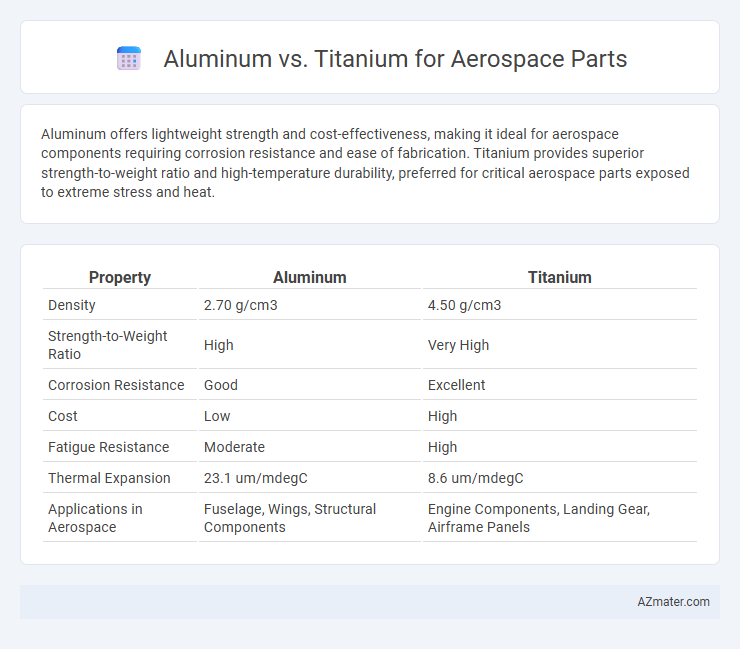Aluminum offers lightweight strength and cost-effectiveness, making it ideal for aerospace components requiring corrosion resistance and ease of fabrication. Titanium provides superior strength-to-weight ratio and high-temperature durability, preferred for critical aerospace parts exposed to extreme stress and heat.
Table of Comparison
| Property | Aluminum | Titanium |
|---|---|---|
| Density | 2.70 g/cm3 | 4.50 g/cm3 |
| Strength-to-Weight Ratio | High | Very High |
| Corrosion Resistance | Good | Excellent |
| Cost | Low | High |
| Fatigue Resistance | Moderate | High |
| Thermal Expansion | 23.1 um/mdegC | 8.6 um/mdegC |
| Applications in Aerospace | Fuselage, Wings, Structural Components | Engine Components, Landing Gear, Airframe Panels |
Introduction: Aluminum vs Titanium in Aerospace
Aluminum and titanium are two critical materials extensively used in aerospace engineering due to their unique properties impacting performance and cost. Aluminum offers a lightweight structure with excellent corrosion resistance and high strength-to-weight ratio, making it ideal for fuselage and wing components. Titanium provides superior strength, high temperature resistance, and exceptional durability, favored in engine parts and landing gear where extreme conditions demand enhanced material performance.
Material Properties Overview
Aluminum offers a high strength-to-weight ratio and excellent corrosion resistance, making it a popular choice for aerospace components that require lightweight durability. Titanium provides superior strength, higher melting point, and exceptional resistance to fatigue and corrosion, especially in extreme temperatures and harsh environments. Both materials are critical in aerospace design, with aluminum favored for cost-effectiveness and ease of machining, while titanium is preferred for high-performance applications requiring maximum strength and thermal stability.
Strength-to-Weight Ratio Comparison
Titanium outperforms aluminum in aerospace applications due to its superior strength-to-weight ratio, offering nearly twice the strength while maintaining a comparable density of about 4.5 g/cm3 versus aluminum's 2.7 g/cm3. The high tensile strength of titanium alloys, often exceeding 900 MPa, provides enhanced durability and fatigue resistance critical for aerospace parts subjected to extreme stresses. Aluminum alloys, though lighter, require thicker sections to match titanium's strength, resulting in less efficient weight savings and limited performance under high-temperature conditions.
Corrosion Resistance and Durability
Titanium exhibits superior corrosion resistance in aerospace applications due to its ability to form a stable oxide layer, protecting it from oxidation and various chemical exposures. Aluminum, while lightweight and cost-effective, is more prone to corrosion, especially in saline or acidic environments, requiring protective coatings or treatments for durability. Titanium's higher strength-to-weight ratio and resistance to fatigue make it more durable for critical aerospace parts subjected to extreme conditions.
Performance in Extreme Temperatures
Titanium offers superior performance in extreme temperatures compared to aluminum due to its high melting point of approximately 1,668degC and excellent strength retention at elevated temperatures. Aluminum, with a melting point around 660degC, experiences significant strength loss and thermal expansion issues under intense heat, limiting its usage in high-temperature aerospace applications. The high strength-to-weight ratio and corrosion resistance of titanium make it the preferred material for aerospace parts exposed to extreme thermal conditions.
Machinability and Manufacturing Considerations
Aluminum alloys exhibit superior machinability with faster cutting speeds and lower tool wear, making them favorable for aerospace parts requiring complex shapes and high production volumes. Titanium offers exceptional strength-to-weight ratios and corrosion resistance but poses greater challenges in machining due to its low thermal conductivity and work hardening, necessitating specialized tooling and slower feed rates. Manufacturing considerations prioritize aluminum for cost-efficiency and ease of fabrication, while titanium is chosen when performance under extreme conditions outweighs machining complexity.
Cost Analysis: Aluminum vs Titanium
Aluminum offers a lower material cost and easier machinability compared to titanium, making it the preferred choice for budget-sensitive aerospace projects. Titanium, while significantly more expensive, provides superior strength-to-weight ratio and corrosion resistance, which can reduce maintenance expenses and extend part longevity. An in-depth cost analysis must weigh upfront material and manufacturing expenses against long-term performance benefits and lifecycle costs for aerospace components.
Common Aerospace Applications
Aluminum is widely used in aerospace applications such as aircraft fuselages, wing structures, and engine components due to its lightweight, corrosion resistance, and excellent strength-to-weight ratio. Titanium is preferred for critical parts like landing gear, jet engine components, and airframe structures where high strength, heat resistance, and fatigue performance are essential. Both metals optimize performance, with aluminum excelling in large structural parts and titanium dominating in high-stress, high-temperature environments.
Sustainability and Environmental Impact
Aluminum offers lightweight properties and high recyclability, making it a sustainable choice with a lower environmental footprint in aerospace manufacturing. Titanium, while more energy-intensive to extract and process, provides superior strength-to-weight ratio and corrosion resistance, extending the lifespan of aerospace parts and reducing replacement frequency. Evaluating lifecycle emissions, aluminum's recyclability contrasts with titanium's durability benefits, highlighting trade-offs between immediate environmental impact and long-term sustainability in aerospace applications.
Choosing the Right Material for Aerospace Parts
Aluminum offers a lightweight and cost-effective solution with excellent corrosion resistance and good strength-to-weight ratio, making it ideal for large structural aerospace components. Titanium provides superior strength, high-temperature resistance, and exceptional fatigue performance, suitable for critical parts subjected to extreme stress and heat. Selecting the right material requires balancing factors like weight, mechanical properties, cost, and environmental conditions specific to the aerospace application.

Infographic: Aluminum vs Titanium for Aerospace Part
 azmater.com
azmater.com